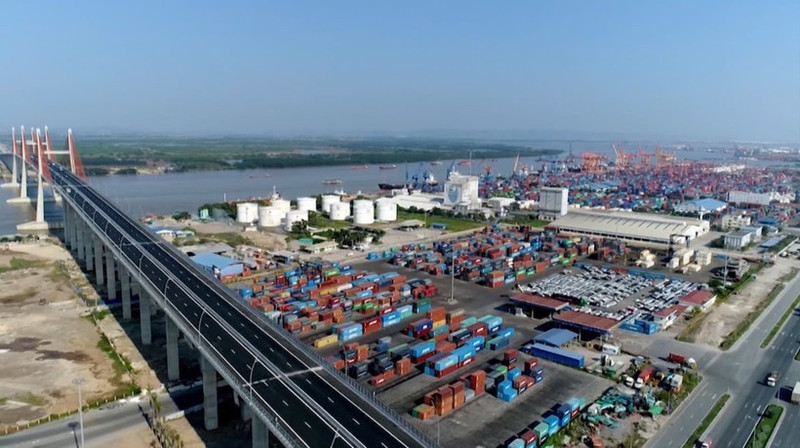Logistics: economic lifeblood and young workforce gap
“A vehicle with… legs” may be a joke, but it’s a story shared by Do Thu Phuong, Chairwoman of the Board of Directors of KA Logistics Company, when meeting with transport students. Many were baffled by basic professional concepts, “three-legged vehicle, four-legged vehicle”, familiar terms for trucks associated with transport load.

Young logistics graduates unprepared for the real world
At a training programme for lecturers in logistics and supply chain management, many representatives of universities and businesses acknowledged a concerning reality: young graduates often feel lost when entering the professional work environment.
“Many cannot distinguish between senders and recipients, or have never even completed a full set of import-export documents. These gaps create real barriers that hinder graduates from adapting to the job, even after completing their studies,” assessed Tran Tuan Duc, Director of Real Logistics Company.
Graduates often do not know where they fit in the logistics operations chain, what they should be doing, or who they should be coordinating with. They lack both practical skills and an overarching view of the profession they have chosen.
“A lot of young people lack both the skills and the big-picture understanding of the sector they’re entering,” Duc emphasised.
A lecturer from the University of Economics – Technology for Industries posed a direct question to businesses: "With the current training program, what positions do businesses find 'difficult to recruit' and 'need to recruit'? What should we adjust?"
This shows that the issue of how to train appropriately is also "making it difficult" for universities. A graduate whose training does not align with market demand is essentially a failed outcome.
The logistics sector, which is often described as the economy’s "blood vessel", is now facing an ironic situation of having “too many planners, too few workers”. Many students are drawn in by a romanticised image of the field, while lacking a realistic understanding.
As Ms. Phuong pointed out, logistics is far from a “white-collar” job. It involves significant physical tasks such as loading and unloading goods, inventory checks, vehicle operations, and warehouse management. It also requires agile coordination between departments and high time pressure to ensure a smooth supply chain. Therefore, early practical exposure is essential for students to fully grasp each link in the logistics chain and prepare for their future roles.
Logistics includes a lot of "manual" work such as loading and unloading, counting goods, operating vehicles and managing warehouses.
Phuong shared that logistics is not an easy job, but it involves “manual" work such as loading and unloading goods, counting goods, vehicle operations, and warehouse management. It also requires agile coordination between departments and high time pressure to ensure a smooth supply chain. Therefore, early practical exposure is essential for students to fully grasp each link in the logistics chain and prepare for their future work.
Because of such incomplete perspectives, the consequence is that businesses lose time retraining, students lose direction, and universities "struggle" between theory and practice.
Meanwhile, the global trade context, e-commerce development, and digital transformation requirements are putting great pressure on high-quality logistics human resources. If not changed promptly, the gap between training and businesses will increasingly widen, and students will fall behind the social needs.
Need for a training ecosystem linked to practice
Faced with this situation, all stakeholders agree that it needs an effective coordination mechanism between universities, businesses and state management agencies to train logistics human resources in line with actual needs.
Tran Thanh Hai, Deputy Director of the Import-Export Department under the Ministry of Industry and Trade, affirmed the importance of connecting and training high-quality human resources in the logistics industry.
Deputy Director General of the Agency of Foreign Trade under the Ministry of Industry and Trade, underscored the importance of this connection: “Regulatory bodies will work alongside schools and businesses to resolve obstacles in both training and practice. The output of universities is the input for businesses. Without strong collaboration, we cannot build a quality workforce.”
Phung Mai Lan, Deputy Head of the Faculty of Economics and Management at Thuy Loi University (Univesity of Water Resources), stressed that training programmes must not only equip students with theoretical knowledge but also help lecturers update their practical skills, so they can bring the real world into the classroom and teach what businesses need.
From the business side, they are ready to partner with universities by sharing real-world data, accepting interns, and co-developing integrated training models such as the CO-OP programme proposed by the Viet Nam Logistics Business Association. This model allows students to gain early exposure to real-world scenarios, so they can become job-ready upon graduation.
Some leading logistics businesses have already begun developing in-house training centres or collaborating with universities to offer specialised training courses, invite industry professionals as guest lecturers, host skills competitions, or run short-term guided internships. These models are highly praised for creating a more cohesive and effective “training ecosystem”.
An integrated training programme involving universities, industry, and management agencies is key to improving the quality of the logistics workforce.
The output of the universities is the input of enterprises. When lecturers are equipped with practical knowledge, students gain actual working experience, and businesses actively support the process, the logistics sector will be able to develop a professional human resource, meeting the demand of development and international integration.
Only with a long-term and unified strategy, Viet Nam’s logistics sector can truly become competitive and achieve sustainable development in the context of deep global integration today.








